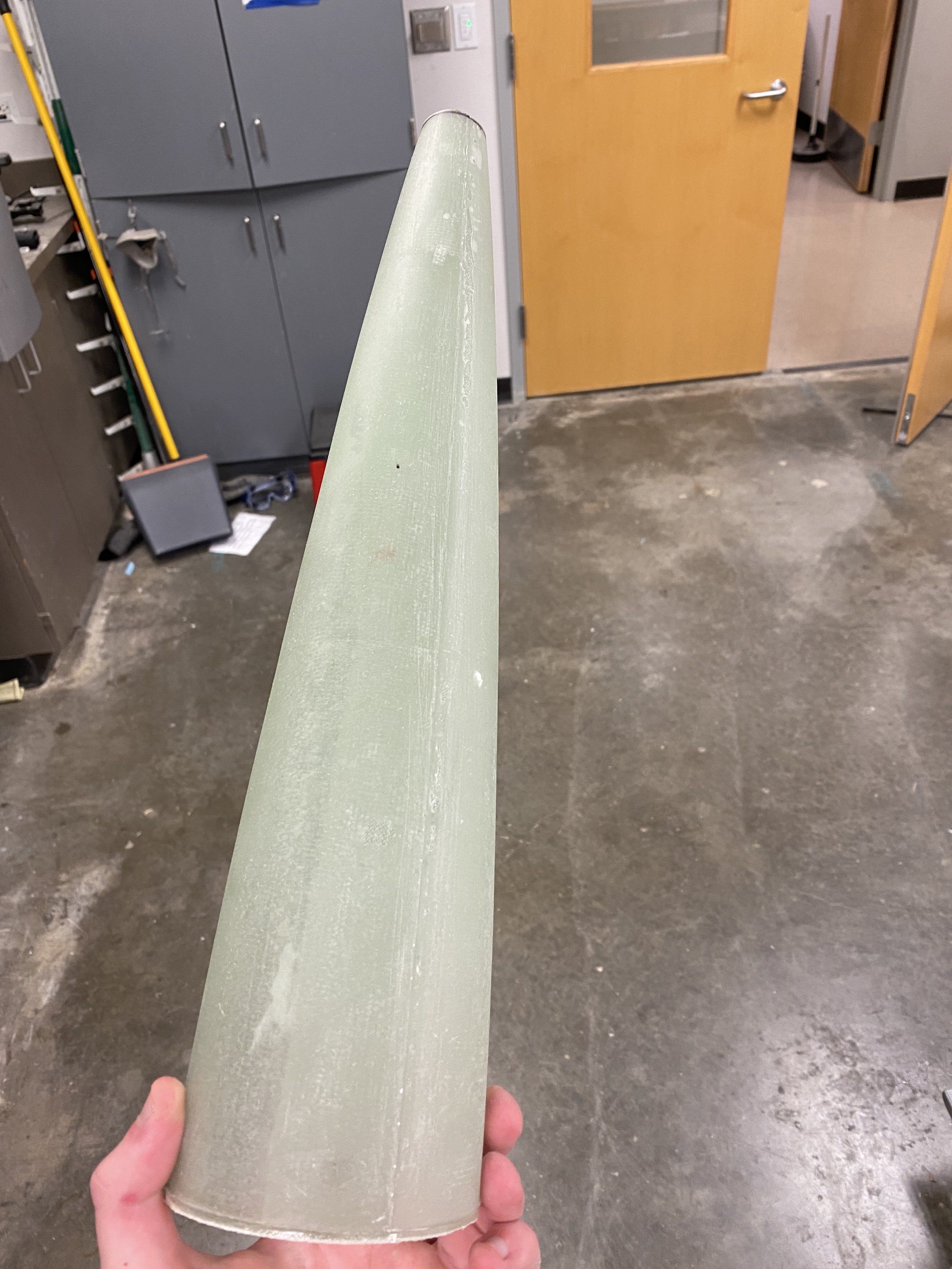Meet Echo, the breaker of barriers
Echo is an experimental high-speed rocket, designed to reach Mach 3 while remaining under 32,000 feet. With this project, we are pushing the boundaries of what is possible, striving to design and build a rocket that can travel faster than anything we have created before. We decided to undertake this project as a test of our fabrication abilities, which is why we chose to create every component, including the nose cone, fins, and body tubes from scratch.
Along with Echo came a variety of challenges. Each component, including a scratch-made fiberglass nose cone, fins that could withstand incredibly high forces and heat, and a carbon fiber body tube longer than one that we had ever made before, presented us with challenges that we had to overcome as a team.
Despite the many challenges involved, the potential rewards are great and the opportunities to learn and improve are limitless. Serving as a proving ground for our manufacturing capabilities, Echo will lay the foundation for future space-shot rockets made by the Longhorn Rocketry Association.
Launch Control, this is Austin. We are GO for launch.
Project Echo’s official mission patch.
Design
Single- Stage
Dual-Deploy (separate ejections for drogue parachute and main parachute)
Expected Altitude: 28,000 ft.
Fins
The fin design for Echo has been optimized for supersonic flow while maintaining strength and conforming to fin flutter constraints. It uses a clipped delta profile with a symmetric double diamond cross-section. The core will be constructed out of G10 fiberglass laminate and covered in a carbon fiber tip-to-tip layup. The tip-to-tip process will greatly strengthen the fins and increase the strength with which they're held to the body tube.
Fins with 0.75 in. radius filet
Mach 2.5 flow over leading and trailing edges of fin
Shock wave visualization of Mach 2.5 flow over cross-section of fin
Force results showing the resulting applied force on the face of the fin, total drag force, and skin-friction drag respectively
Fin Flutter
Initially, we wanted the fins to be created from 6061 aluminum alloy. However, aluminum has issues with sticking to epoxy unless it is first treated with a sulfuric acid-dichromate mixture. This issue could be overcome by making the fins out of G10 fiberglass. We ultimately decided to use G10 as it does not have these adhesion issues while also having a high enough rigidity to withstand the expected speeds of our rocket without fin flutter becoming an issue. We used a MATLAB script which utilizes flutter boundary equations, the dimensions of our trapezoidal fins, and the material properties of aluminum and fiberglass to calculate flutter velocities at different altitudes to determine if fiberglass would be rigid enough to withstand the velocities associated with Echo.
Analysis of fin flutter velocities of aluminum and fiberglass of Echo’s specific fin dimensions
Nose Cone
In the interest of reducing material costs, we are in the process of developing our first-ever in-house nose cone. First laying up fiberglass in two individual halves of a 3D-printed mold, the two halves are clamped together and a bladder is inflated to pressurize the interior of the mold and squeeze out excess resin. Once cured, the nose cone is separated from the mold, and excess material is trimmed off, allowing for the precise location of an eventual threaded aluminum tip.
Early 50% scale prototypes
Freshly laid-up nose cone with an inflatable bladder inside the mold
First generation full-size nose cone
Cured nose cone being removed from the 3D-printed molds
Nose cone with a threaded aluminum tip
Electronics Bay
One of the primary goals of Echo is to go as fast as possible within the altitude restrictions. To achieve that, we need to minimize the length of the rocket while maintaining the standard functions and safety requirements. Rather than housing an electronics bay in the midsection of the rocket, the core electronics of Echo will reside on a 3D-printed sled in the nose cone. The dual-redundant TeleMega and EasyMega flight computers, as well as the wifi switch and batteries, will all be contained within the nose cone, while also functioning as a retainer for the aluminum tip and recovery system.
CAD renderings of the assembled electronics bay
Body Tubes
Echo is composed of two carbon fiber body tubes, 48in. and 10in. long. Constructed of six layers of 2x2 twill weave carbon, the body tubes can easily withstand the necessary forces while keeping weight to a minimum.
Uncut, raw body tube prototype
Uncut, polished body tube prototype
Blue Tube, fiberglass, and carbon fiber body tubes after being tested on an Instron machine. Blue Tube withstood 16,000N of force, fiberglass 64,000N, and carbon fiber 94,000N.
Motor
Echo will be flying on a Cesaroni M2245 IMAX.
Total Impulse: 9976.7 Ns (2242.8 lb/s)
Average Thrust: 2326.4 N (523 lb)
Maximum Thrust: 3357 N (754.7 lb)
Burn time: 4.29 seconds
Dimensions: 75 x 1025 mm (2.95 x 40.35 in)


























